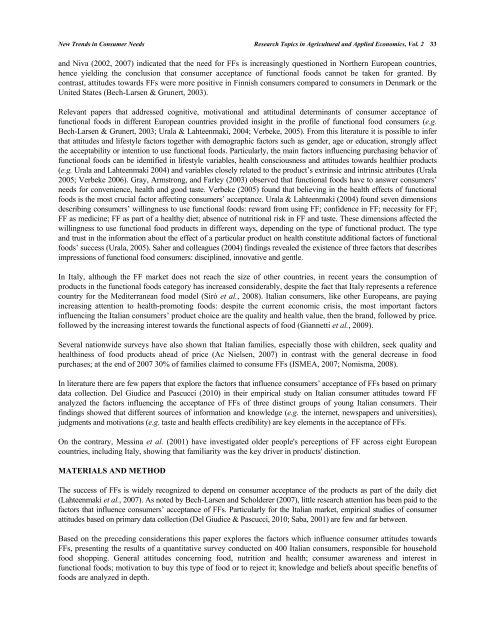chapter 2 - Bentham Science
chapter 2 - Bentham Science
chapter 2 - Bentham Science
You also want an ePaper? Increase the reach of your titles
YUMPU automatically turns print PDFs into web optimized ePapers that Google loves.
New Trends in Consumer Needs Research Topics in Agricultural and Applied Economics, Vol. 2 33<br />
and Niva (2002, 2007) indicated that the need for FFs is increasingly questioned in Northern European countries,<br />
hence yielding the conclusion that consumer acceptance of functional foods cannot be taken for granted. By<br />
contrast, attitudes towards FFs were more positive in Finnish consumers compared to consumers in Denmark or the<br />
United States (Bech-Larsen & Grunert, 2003).<br />
Relevant papers that addressed cognitive, motivational and attitudinal determinants of consumer acceptance of<br />
functional foods in different European countries provided insight in the profile of functional food consumers (e.g.<br />
Bech-Larsen & Grunert, 2003; Urala & Lahteenmaki, 2004; Verbeke, 2005). From this literature it is possible to infer<br />
that attitudes and lifestyle factors together with demographic factors such as gender, age or education, strongly affect<br />
the acceptability or intention to use functional foods. Particularly, the main factors influencing purchasing behavior of<br />
functional foods can be identified in lifestyle variables, health consciousness and attitudes towards healthier products<br />
(e.g. Urala and Lahteenmaki 2004) and variables closely related to the product’s extrinsic and intrinsic attributes (Urala<br />
2005; Verbeke 2006). Gray, Armstrong, and Farley (2003) observed that functional foods have to answer consumers’<br />
needs for convenience, health and good taste. Verbeke (2005) found that believing in the health effects of functional<br />
foods is the most crucial factor affecting consumers’ acceptance. Urala & Lahteenmaki (2004) found seven dimensions<br />
describing consumers’ willingness to use functional foods: reward from using FF; confidence in FF; necessity for FF;<br />
FF as medicine; FF as part of a healthy diet; absence of nutritional risk in FF and taste. These dimensions affected the<br />
willingness to use functional food products in different ways, depending on the type of functional product. The type<br />
and trust in the information about the effect of a particular product on health constitute additional factors of functional<br />
foods’ success (Urala, 2005). Saher and colleagues (2004) findings revealed the existence of three factors that describes<br />
impressions of functional food consumers: disciplined, innovative and gentle.<br />
In Italy, although the FF market does not reach the size of other countries, in recent years the consumption of<br />
products in the functional foods category has increased considerably, despite the fact that Italy represents a reference<br />
country for the Mediterranean food model (Sirò et al., 2008). Italian consumers, like other Europeans, are paying<br />
increasing attention to health-promoting foods: despite the current economic crisis, the most important factors<br />
influencing the Italian consumers’ product choice are the quality and health value, then the brand, followed by price.<br />
followed by the increasing interest towards the functional aspects of food (Giannetti et al., 2009).<br />
Several nationwide surveys have also shown that Italian families, especially those with children, seek quality and<br />
healthiness of food products ahead of price (Ac Nielsen, 2007) in contrast with the general decrease in food<br />
purchases; at the end of 2007 30% of families claimed to consume FFs (ISMEA, 2007; Nomisma, 2008).<br />
In literature there are few papers that explore the factors that influence consumers’ acceptance of FFs based on primary<br />
data collection. Del Giudice and Pascucci (2010) in their empirical study on Italian consumer attitudes toward FF<br />
analyzed the factors influencing the acceptance of FFs of three distinct groups of young Italian consumers. Their<br />
findings showed that different sources of information and knowledge (e.g. the internet, newspapers and universities),<br />
judgments and motivations (e.g. taste and health effects credibility) are key elements in the acceptance of FFs.<br />
On the contrary, Messina et al. (2001) have investigated older people's perceptions of FF across eight European<br />
countries, including Italy, showing that familiarity was the key driver in products' distinction.<br />
MATERIALS AND METHOD<br />
The success of FFs is widely recognized to depend on consumer acceptance of the products as part of the daily diet<br />
(Lahteenmaki et al., 2007). As noted by Bech-Larsen and Scholderer (2007), little research attention has been paid to the<br />
factors that influence consumers’ acceptance of FFs. Particularly for the Italian market, empirical studies of consumer<br />
attitudes based on primary data collection (Del Giudice & Pascucci, 2010; Saba, 2001) are few and far between.<br />
Based on the preceding considerations this paper explores the factors which influence consumer attitudes towards<br />
FFs, presenting the results of a quantitative survey conducted on 400 Italian consumers, responsible for household<br />
food shopping. General attitudes concerning food, nutrition and health; consumer awareness and interest in<br />
functional foods; motivation to buy this type of food or to reject it; knowledge and beliefs about specific benefits of<br />
foods are analyzed in depth.

















